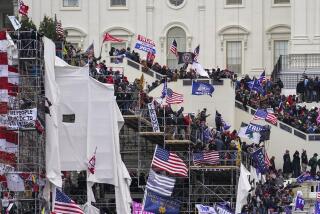U.S. History Comes Alive in His Tours and Tales
WASHINGTON — Even at 5:29 in the morning, Edwin C. Bearss’ voice is booming--full of passion for the history of our country.
He’s off to Mississippi to lead a four-day Smithsonian Institution tour on Maj. Gen. Ulysses S. Grant’s successful 1863 campaign to capture Vicksburg. Then, without a break, it’s on to Shiloh, Tenn., to lead a three-day Blue and Gray Education Society tour of the battlefield where more than 13,000 Union and 10,500 Confederate troops were killed or wounded April 6-7, 1862.
The fast pace is typical for Bearss, chief historian emeritus of the National Park Service, who loves to walk America’s battlefields and historic sites while delivering dynamic lectures.
“It’s like he just had dinner with these people, he brings them so alive,” says a veteran of Bearss’ Valley Forge tour. “He talked nonstop for 12 hours and there wasn’t a dull moment.”
At 78 Bearss remains energetic and ebullient.
He’s doing 40 tours this year for the Smithsonian and other outfits, some a week long: “Sherman’s March to the Sea,” “The Road to Gettysburg,” “The Black Hawk War and the Great Sioux Uprising of 1862,” “Boston: Cockpit of the Revolution,” “Battle of the Little Bighorn,” “Quebec City: A Military History” and others. His tours are usually sold out within an hour of being posted.
Washington lawyer Bill Vodra remembers Bearss at Gettysburg’s Little Round Top: “His voice carries, and all of a sudden the crowd tripled as tourists joined us. Jaws were dropping, people recognized him from the Ken Burns ‘Civil War’ series. Writer Mike Kernan described the hillside covered with people [and quoted someone as saying], ‘It was like the Sermon on the Mount.’”
In Quebec City, Vodra recalls Bearss leading a group through an alley in a driving rain, tracing the route American commander Benedict Arnold had followed in an unsuccessful 1775 assault.
“He’s a national treasure,” says Vodra, who has been on more than 70 trips with Bearss. “He’s not pedantic and not a showoff. If he gets something wrong he’ll say, “Thank you for correcting me.’”
“First off, I like people,” Bearss says in an interview in his Park Service cubbyhole. “I don’t view any of their questions as foolish. I’ve never led a tour where I haven’t learned something new myself. And giving a presentation is an emotional experience; it gives me a high!”
Even indoors, Bearss’ voice had a strong, dramatic quality. He says his first speech half a century ago was a boring flop and he vowed never to let it happen again.
He masters his material ahead of time, avoids notes, employs a hearty tone. Outdoors, he strides up and down, gesticulating with a riding crop and often leading his audience miles across rugged terrain where events took place.
“I always walk the ground,” he said. “It’s critical in understanding what happened.”
Bearss was born in Montana and grew up on a ranch, riding horseback to school. He got hooked on Civil War history in the seventh grade when his dad introduced him to a biography of Jeb Stuart, the famous Confederate cavalry officer.
At 18, Bearss joined the Marines and fought in the Pacific in World War II. He was wounded and spent 26 months in hospitals, reading history. After receiving degrees from Georgetown and Indiana universities, he joined the National Park Service at Vicksburg in 1955 as a historian.
There, he discovered the underwater remains of the Union ironclad Cairo, which became the subject of the first of his 15 books.
More to Read
Sign up for Essential California
The most important California stories and recommendations in your inbox every morning.
You may occasionally receive promotional content from the Los Angeles Times.










